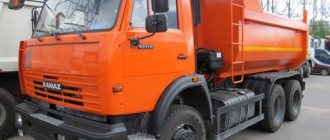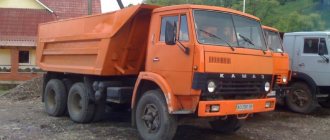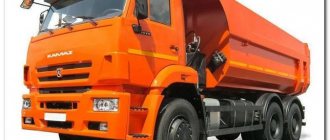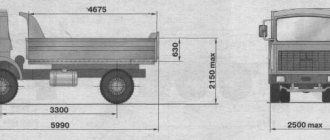Table of body volumes of some domestic dump trucks
Dump truck “Tonar” 85791 – 0000020
| Vehicle type | Body volume | Load capacity |
| 10.5 m³ | ||
| Dump truck "Tonar 6528" | 16 m³ | |
| Dump truck “Tonar 8579 – 0000030” | 12.34 m³ | |
| Semi-trailer “Tonar 95234 – 0000030” | 43.5 m³ | 45 t |
| Mining dump truck "Tonar-45251" | 45 m³ | 45 t |
| KAMAZ-43255 6 m³ 7.7 t. | 6 m³ | 7.7 t. |
| KAMAZ-65115 10 m³ 15 t. | 10 m³ | 15 t. |
| KAMAZ-6520 12 m³ 20 t. | 12 m³ | 20 t. |
| KAMAZ-65201 16/20 m³ 25.5 t. | 16/20 m³ | 25.5 t. |
Body manufacturing technology
The production of bodies for modern dump trucks requires the organization of complex production associated with the processing of large-format sheet steel. Dump truck manufacturers often order and purchase bodies from companies specializing in these products.
For serial production of bodies it is necessary:
- sheet bending and gas cutting equipment;
- high-strength alloy steel made in Europe with hardness HB450;
- working documentation for bodies.
The complexity of manufacturing dump truck bodies lies in the fact that for a large load-bearing capacity of a dump truck, a maximally lightweight body is required, which must withstand operation for many years without deformation or damage.
When transporting rock fragments weighing several tons, dumped by an excavator bucket into the back of a dump truck, it is difficult to avoid damage. But it is also impossible to increase the thickness of the steel sides, since in this case the load-carrying capacity of the vehicle is reduced. The solution is to purchase imported wear-resistant steel, the production of which is not established in Russia.
The production of bodies begins in the cutting area. After cutting, the finished parts are transferred to a press brake, where structural and reinforcing bent elements are formed on the parts. Carry out control assembly of the body. If the product can be transported, it is finally assembled, welded, painted and sent to the customer.
Bodies that cannot be transported assembled due to their large dimensions (for example, for mining dump trucks) are disassembled again and sent in detail to the automaker. There, a team of bodybuilders assembles it, finally welds it and paints it.
The MAZ-5551 truck has been produced by the Minsk Automobile Plant for three decades, since 1985. Despite its far from innovative design (its immediate ancestor, the MAZ-503, first hit the roads back in 1958), the MAZ-5551 dump truck remains one of the most popular eight-ton trucks in Russia. Read about Kamaz 500 series in this article.
Design and equipment
Contents
ATTENTION! A completely simple way to reduce fuel consumption has been found! Don't believe me? An auto mechanic with 15 years of experience also didn’t believe it until he tried it. And now he saves 35,000 rubles a year on gasoline! Read more"
The loading platform of this dump truck is heated using exhaust gases, which prevents the cargo from freezing in low temperatures; in addition, heating facilitates the operation of hydraulics. The cabin (three-seater, tilting, metal) is equipped with a powerful heating system and has good thermal insulation, which ensures comfortable work for drivers in the cold season. The 6x4 chassis allows the dump truck model to operate effectively on any road. A small turning radius, plus a high level of maneuverability, as well as good visibility from the cab, allow loading and unloading even when there is not enough space.
The hydraulic body drive is equipped with a remote tilt control system, which allows you to raise and lower the platform directly from the cab. The platform in the car is welded all-metal; there is a protective canopy above the cabin. The KamAZ-55111 model is produced in different modifications. However, its main indicators, such as: load capacity -13 tons and the capacity of the Kamaz dump truck body (6.6 cubic meters) remain unchanged; the features of some modifications allow the use of these dump trucks in very specific conditions. For example, KamAZ-55111 is a bucket type, unloaded backwards, heated by engine exhaust gases. It has a two-seater cabin (a seat for a second passenger can be installed upon request). The modification is a tropical version, in addition to it there is an “HL” body and a modification for working in cold climates with temperatures down to minus 50.
Body dimensions of model 55111
Model 65115
When the KAMAZ model 55111 has insufficient body volume, then the 65115 model dump truck can be used - the most famous of all the models produced by the Kama plant. It has a load capacity of 15 tons, like all other large-tonnage dump trucks, and is designed for transporting various bulk cargoes. This type of dump truck is used primarily in construction work. Model 65115 is equipped with a motor with a power of 260 horsepower, it is reliable and very economical. The volume of the fuel tank is 350 liters, the volume of the KAMAZ 65115 body is 10 cubic meters. The platform is tilted backwards, the platform rises 60 degrees.
The cabin is spacious and very comfortable, the high driver's seat increases visibility. The large diameter of the wheels, plus a rigid suspension, provide the vehicle with stability and increased cross-country ability on rough terrain. This dump truck is equipped with inter-wheel locking. When fully loaded, the car reaches a speed of 80 km/h. The list of its advantages is complemented by a very reasonable price.
The dump truck's solid body volume, plus its large load capacity and impeccable performance characteristics, have made model 65115 one of the most popular dump trucks on the market.
Dimensions of model 65115
Medium tonnage dump truck
How many cubic meters a KamAZ body can transport is a pressing question; it all depends on its model. Model 65111 has 8 cubic meters of volume for transporting various bulk cargoes.
In addition, the vehicle is used everywhere for the removal of construction or household waste. Not every garbage truck is able to cope with such a volume of garbage, and even more so with a significant mass of this garbage.
Although the bulk of customers for cars of this size are private individuals who are independently constructing some construction projects, the car is no less popular among summer residents for delivering building materials and other goods to garden plots.
Such a KAMAZ, the capacity of the dump truck body is 8 cubic meters, has long proven itself - with its excellent cross-country ability on difficult and even broken road sections, as is known, gardening communities or cottage villages and new buildings do not have good roads. The car has excellent maneuverability, so it can easily cope with difficult turns, passing through narrow streets of garden and cottage villages, and entering rather small gates in summer cottages. The biggest advantage of this model is that the machine breaks up roads or driveways, house lots, just like heavier dump trucks and other vehicles capable of delivering large amounts of cargo do. That is why, when choosing how many cubic meters of cargo you need to deliver in the back of a Kamaz truck, take into account all delivery factors, otherwise you will have to supplement the work of building a private house or landscaping a garden plot with repairing the access road.
Model 65111 has a load capacity of 11-12 tons. It turns out that such cargo as sand, crushed stone or gravel can be loaded into such a vehicle no more than 8-8.5 cubic meters, because the listed materials are quite heavy. And bulk materials, such as peat, earth or earthen soil, various peat mixtures, fertile soils can be transported in large volumes, since these materials weigh much less than sand, gravel and crushed stone, they can be loaded “heaping”. In this case, the total weight of the car is less, but the volume of imported material is much greater. It turns out that a Kamaz dump truck with a volume of 8 cubic meters can be loaded with light cargo, such as peat, peat mixtures, vegetable or fertile soil and soil with a volume of up to 10 cubic meters
To summarize, we repeat once again that the car does not destroy roads on entrances, drives along narrow paths of gardening communities, has a way to maneuver and turn around in narrow spaces, high off-road capability, which made such a car indispensable in the construction of the private sector, delivery of goods to rural areas and to summer cottages.
Sand and crushed stone are today the most necessary materials in the construction of buildings and when planning construction on private plots; the need for them can be very great, which requires the purchase of these materials in volumes of cars. Determining how many cubes of sand or crushed stone will fit in the body of a Kamaz truck for construction needs is the main task.
Description and scope of application
Unlike its long-range counterparts, for example, the ZIL-4520, the more compact and maneuverable MAZ-5551 easily moves in urban environments. Most often he can be found working at a city construction site. The main purpose of this truck is to transport bulk materials, and on a short shoulder, which is determined by its 4x2 drive.
Watch the video:
- Agriculture
- industry
- urban management and road construction
Body characteristics
In the standard version, the MAZ-5551 is equipped with a one-piece body with rear unloading. Folding the tailgate and tipping the body are remote controlled and occur automatically.
There are two seats in the cabin , as can be seen in the photo; between the passenger and driver seats there is space for storing things and documents. The driver's seat is equipped with springs and moves forward and backward, but the steering column can be adjusted in two directions.
The comfort in the standard cabin ends with this and the electrically heated side mirrors; there is not even shock absorption in the places where it is attached.
To access the power units, the cabin tilts forward using a hydraulic drive. Raising the cabin is possible only with the radiator grille open, and the mechanism for actuating the mechanism is located behind the grille itself. Fixation in the lowered form is carried out using a conventional steel cable.
The bottom of the truck is heated by supplying exhaust gases . This design greatly facilitates the use of the dump truck in the cold season. For extreme conditions and temperatures down to -60°C, the MAZ-5551 01 HL model was developed.
The transmission of the basic version is a 5-speed manual gearbox YaMZ-236P; on later models with a load capacity of up to 10 tons, the YaMZ-2361 was installed. Nowadays, Western-made boxes are found on new cars.
There is a stabilizer bar , which significantly reduces the truck's roll when cornering. Front and rear brakes are pneumatically controlled drum brakes.
Classification of dump trucks
Dump trucks (dump trucks and dump truck trains) are vehicles designed to transport various cargoes and unload them using a tipping body.
The body (platform), hinged on the frame, can tilt backwards or to the side at an angle of 45–60°.
The main cargoes transported by dump trucks are bulk (bulk), bulk, semi-liquid (solutions) and rock cargo, as well as cargo that does not require care when unloading.
Dump trucks and tipper road trains make up about a quarter of the trucks in use, and their total carrying capacity is about a third of the carrying capacity of all trucks in use.
Dump trucks can be classified according to 7 main characteristics (Fig. 1):
- a) by purpose - construction, agricultural, quarry, highly specialized;
- b) in the direction of unloading of the body (platform) - rear, side one-sided, side two-sided, three-sided;
- c) by load capacity - small - up to 2 tons, medium - 2–7 tons, large - 7–14 tons, especially large (heavy duty) - over 14 tons;
- d) by type of transport link - dump truck, dump truck train, dump truck trailer, dump truck semi-trailer;
- e) according to adaptability to the type of roads - for all types of roads, for roads of limited use (for roads with a bridge load of no more than 100 kN);
- e) in terms of cross-country ability – heavy-duty off-road vehicles (such as BelAZ), high-cross-country off-road vehicles (4×4, 6×6, etc.),
- road vehicles with normal and all-terrain capability (4×2 or 6×4);
- g) according to suitability for working with a trailer - a single dump truck, a dump truck-tractor.
Figure 1 – Classification of dump trucks
Dump trucks are manufactured on the basis of the chassis of the main models of trucks, trailers, semi-trailers and differ from them in the shape and length of the cargo body, the presence of a subframe and a lifting mechanism for the cargo body.
The most common dump trucks are construction group dump trucks (Fig. 2).
Construction dump trucks are used to transport bulk cargo (earth, sand, crushed stone, gravel, etc.), mortars (concrete, lime, gypsum, soap alkali, etc.) and other various construction cargo (lime-lime brick, cement, etc.).
Construction dump trucks are designed to drive on paved roads and therefore have a 4x2 or 6x4 wheel arrangement. They can be equipped with gasoline or diesel engines and have relatively high maximum speeds (70...90 km/h). Their carrying capacity is 2.25...12 tons, the capacity of the cargo body is 2...7.2 m3, the body tipping is mainly rear, the lifting angle of the body during unloading is 48...60°, and the time of its raising and lowering is 15...20 s.
Figure 2 – Construction dump trucks
In Russia, a number of models of construction dump trucks and their modifications are produced, based on the chassis of GAZ, ZIL, KamAZ trucks, etc.
New construction dump trucks, compared to previously produced ones, have increased load capacity and a larger cargo body volume, more powerful engines and increased towing-speed properties.
Agricultural dump trucks (Fig. 3) are used for transporting bulk and bulk agricultural cargo (fertilizers, feed, grain, silage, corn, vegetables, potatoes, beets, etc.). These dump trucks can also be used for various household and construction works.
Figure 3 – Agricultural dump trucks
Agricultural dump trucks operate in difficult road conditions. When transporting agricultural goods, their off-road mileage is almost half of the total mileage.
Agricultural dump trucks differ from construction dump trucks in their large volumes of cargo bodies and three-way unloading direction. In addition, agricultural dump trucks are additionally equipped with extension sides, which increase the capacity of the bodies by 1.5 - 2 times, which allows for the transportation of relatively lightweight and low-density (density less than 1 t/m3) agricultural cargo to make fuller use of their carrying capacity. When transporting bulk cargo (grain, fertilizers, etc.), agricultural dump trucks are equipped with awnings to prevent them from being blown out of the body.
Load capacity of agricultural dump trucks is 2.4…5.5 tons, body capacity is 4.3…6 m3 (with extension sides 6.7…12.5 m3), body lifting angle during unloading is 48…58°, body lifting and lowering time is 15 With.
In Russia, a number of models of agricultural dump trucks are produced, based on the chassis of GAZ, ZIL, KamAZ trucks, etc.
Quarry dump trucks (Fig. 4) are used in open mine workings. These dump trucks, as a rule, have a particularly large load capacity, with a diesel engine running on environmentally friendly fuel to prevent gas pollution in deep quarries.
Quarry dump trucks are designed for transporting rocks and solid minerals (ore, coal, etc.). They are used for off-road work, and their movement on asphalt roads is unacceptable due to the large axle loads and specific pressure of the wheels on the road surface.
Figure 4 – Mining dump trucks
Mining dump trucks usually have a 4x2 wheel arrangement, a short wheelbase, high-power diesel engines (300...1700 kW), automatic transmissions (hydromechanical, electric), hydropneumatic suspension, single and double cabins. All this provides them with increased traction and speed properties (maximum speeds of 50...60 km/h), high maneuverability and smooth running, as well as good working conditions for drivers.
These dump trucks have good maneuverability due to high ground clearance (500...700 mm), large diameter (1.5...2.5 m) and significant wheel width (0.5 m or more); the carrying capacity of mining dump trucks is 30...180 tons, the capacity of the cargo body is 15...70 m3, the body tipping is rear, the body lifting angle is 50...55°, and its lifting time is 22...25 s. Lateral tipping of the cargo body is not used on mining dump trucks due to their insufficient lateral stability during unloading.
BelAZ dump trucks (Fig. 5), which are produced in the Republic of Belarus, are also quarry trucks.
Figure 5 – BelAZ mining dump truck
Highly specialized dump trucks (Fig. 6) are used to transport only one specific type of cargo (concrete trucks, cement trucks, mineral trucks, grain trucks).
Most often, such dump trucks are unloaded backwards. Dump trucks are produced with preliminary lifting of cargo (unloading onto a train).
Bodies can be removable (replaceable) and self-unloading. The latter are designed to work within the construction site. The center of gravity of the loaded body is located behind the body support (in the direction of its unloading). After unlocking the lock (lock) holding the rear side of the body, it tips over under the influence of a moment with the shoulder from the center of gravity to the support. The center of gravity of the empty body is in front of the support. Therefore, after the load slides, the body tends to lower to its original horizontal position.
Figure 6 – Highly specialized dump trucks
MAZ 5551 model engine and fuel consumption
The MAZ-5551 engine is a diesel V6 (like the MAZ-53366). Until recent years, all MAZ-5551 dump trucks were equipped with a 180-horsepower YaMZ-236M2 from the Yaroslavl Motor Plant. In new modifications it is replaced by YaMZ-6563.10 with Euro-3 environmental class, and on some models - with Cummins engines with Euro-4 class and turbocharging.
Despite the appearance of configurations with an imported engine, units from YaMZ are still recommended on driver forums for their reliability and ease of maintenance.
MAZ-5551 is distinguished by low fuel consumption per 100 km for its class. Consumption is about 23 liters at a speed of 60 km/h and a load of approximately 85% of the maximum. For comparison, the MAZ-5337 model has a fuel consumption of 30-35 l/100 km.
Specifications
Overall dimensions, mm
- length - 5990 (with the cab tilted - 7850)
- width - 2500 mm (in models with unloading on 3 sides - 3450 with the body fully tilted)
- height - 2925 mm
- with the body tilted back - 4850
- when unloading sideways - 3850
Device motor parameters
- Volume - 11150 cm³ (YaMZ-236)
- Power - 180 hp
- Torque - 667 Nm
- Maximum speed - 83 km/h (some models can have up to 90 km/h)
Weight of MAZ-5551 in standard version, kg
- equipped - 7580, incl.
- on the front axle - 4130
- on the rear axle - 3450
- full - 16,230, incl.
- on the front axle - 5980
Load capacity and body capacity of MAZ-5551
- load capacity - 8500 kg
- body volume is 5.4 m³, while
Dimensions and dimensions of the body
The dimensions of the MAZ-5551 with such a platform volume are 3800 x 2269 x 630 mm.
For comparison, we suggest that you familiarize yourself with the size of the KamAZ flatbed body.
Depending on the modification, the carrying capacity can be up to 10.2 tons (comparable to the carrying capacity of KamAZ-43118), the volume of the MAZ-5551 body can be up to 12.5 m³ (15.5 with raised sides).
Tipper trailers and semi-trailers
Dump trailers and semi-trailers can significantly increase the load capacity and productivity of dump trucks, as well as reduce the cost of transport work. In this regard, dump trucks are becoming increasingly widespread.
When transporting goods, towing of dump truck trailers (Fig. 14) is carried out by dump trucks, and transportation of semi-trailer dump trucks (Fig. 15) is carried out by tractor vehicles (Fig. 16). At the same time, the maneuverability, cross-country ability and stability of road trains with dump trailers are significantly lower than road trains with dump semi-trailers.
Figure 14 – Dump trailers
Dump trailers and semi-trailers have one or two axles and are equipped with metal welded tipping bodies with rear or three (rear and two side) opening sides. Their bodies can also be additionally equipped with removable extension sides. The direction of unloading of trailers and semi-trailers-dump trucks is rear or side on both sides. Their carrying capacity is 4...13.5 tons, and the body capacity is 3...8 m3. The lifting mechanism of the body of trailers and semi-trailers of dump trucks is hydraulically driven from the towing vehicle.
Figure 15 – Dump semi-trailers
The lifting mechanism is designed to ensure unloading of the dump truck body by tilting it (tipping it over) and then returning it to its original (transport) position. It also ensures that the body is fixed in any intermediate position when it is raised and lowered.
Hydraulic lifting mechanisms come with manual and remote control by a control valve (hydraulic distributor).
Figure 16 – Dump truck trains
Loading platform drive
The MAZ-5551 body lifting device is located under the platform. The tipping mechanism, like most modern dump trucks, is hydraulic with pneumatic control.
The telescopic hydraulic cylinder with variable displacement consists of three sequentially extending links - this design allows the development of sufficient working forces with a small weight and dimensions when folded. Its main disadvantage is its significant complexity, as well as the risk of clogging tightly fitting links.
To increase the safety of unloading, a safety device is provided in the control valve of the hydraulic cylinder. It does not allow the platform to be fully lifted when overloading more than 1.5 tons.
The tailgate axles are controlled by a pneumatic cylinder, which is activated when the device handle is moved to the “Lift” position.
Calculation of weight and cubic meters
Calculation of the volume of sand transported in a car depends on its carrying capacity, so it is important to take this fact into account; sometimes, due to the weight, it is not possible to load the full body. Therefore, the shipment and sale of all bulk materials to vehicles is strictly regulated, everything depends on the capabilities of the truck platform.
Kamaz dump trucks have capacities of 6,8,10,12 cubic meters; for large volumes of supplies, HOWO (DongFeng) dump trucks with volumes of 20 and 25 cubic meters are used.
Approximate calculations of the weight and volume of sand in trucks:
- Since the instructions for KAMAZ 65115 body volume of six cubic meters allows loading dry construction sand with a density of 1600 kg/m3 (average) will have a weight of 1600 * 6 = 9600 kilograms or 9.6 tons
- And with a body volume of 8 cubic meters of the same sand with a density of 1600 kg/m3, 1600 * 8 = 12800 kilograms or 12.8 tons are loaded
- 10 cubic meters of sand will have a weight of 1600 * 10 = 16000 kilograms or 16 tons
- 12 cubic meters is already 19.2 tons
- 20 cubic meters of sand is 32 tons.
- And 25 cubic meters comes out to 1600 * 25 = 40,000 kilograms or as much as 40 tons.
Important: We should not forget that in our calculations the density of sand is taken as an approximate value (average value), the density strongly depends on its characteristics - composition, taking into account impurities and fraction size and the degree of moisture and compaction.
Bulk density for sand varies widely under different weather conditions, which is why, when purchasing material, you always need to clarify this important parameter, since the truck may not be able to deliver the required volume due to the load capacity limit.
Here's a simple example:
- The carrying capacity of the machine is 10 tons, and the volume of the body is only 6 cubic meters, the density of transported sand is 1600 kg/m3
- Based on calculations, 6 * 1600 = 9.6 tons - the vehicle is capable of delivering this cargo
- However, this car will not be able to bring 6 cubic meters of sand with a density of 1800 kg/m3, according to calculations it comes out to 6 * 1800 = 10.8 tons, which means overloading the car, this is unacceptable
Calculations of cubic meters of sand for KAMAZ trucks were made taking into account the maximum load capacity of the vehicle, while taking into account the bulk density of sand:
- For example, a machine with a carrying capacity of 10 tons is capable of transporting from 5 to 8.5 cubic meters of sand with a bulk density of 1200-1800 kg/m3 (10000 / 1200 = 8.33; 10000 / 1800 = 5.55)
- And KamAZ, with a carrying capacity of 17 tons, will deliver about 10 cubic meters of sand with a density of 1600 kg/m3 (17000 / 1600 = 10.6)
- A dump truck with a carrying capacity of 31 tons makes it possible to deliver approximately 20 cubic meters of sand (here the possibilities are limited by the capacity of the body - 31000 / 1600 = 19.4)
- A quarry truck with a carrying capacity of up to 50 tons, makes it possible to deliver up to 25 cubic meters of sand (the capacity of the body limits the capabilities to 50,000 / 1,600 = 31.25)
Clutch adjustment
The MAZ-5551 is equipped with a traditional double-disc friction clutch . The elements of this unit are subject to wear due to significant overloads during operation and require periodic maintenance.
Adjusting the MAZ-5551 clutch is required, for example, in the following cases:
- clutch slipping at high speeds
- crackling sound when changing gear
- The clutch doesn't disengage completely
There are three main stages:
1. Setting the gap of 1 mm between the adjusting screws and the middle drive disk is carried out as follows:
- remove the hatch covers to gain access to the clutch and flywheel,
- with the clutch engaged, move the gearshift lever to neutral,
- unscrew the locknuts and screw all the adjusting screws into the middle drive disk until it stops; to do this, turn the flywheel,
- Loosen the screws 1 turn and tighten the locknuts with slight force.
This adjustment ensures the required distances between the discs and the friction surface of the flywheel.
2. Ensuring a gap of 3.3...3.7 mm between the nut and the rear valve cover. To adjust, you need to loosen the lock nut and set the gap to the desired size by tightening the adjusting nut.
3. Adjusting the pedal free play. The standard value is 34-43 mm (measured with a ruler when the pneumatic system is empty).











